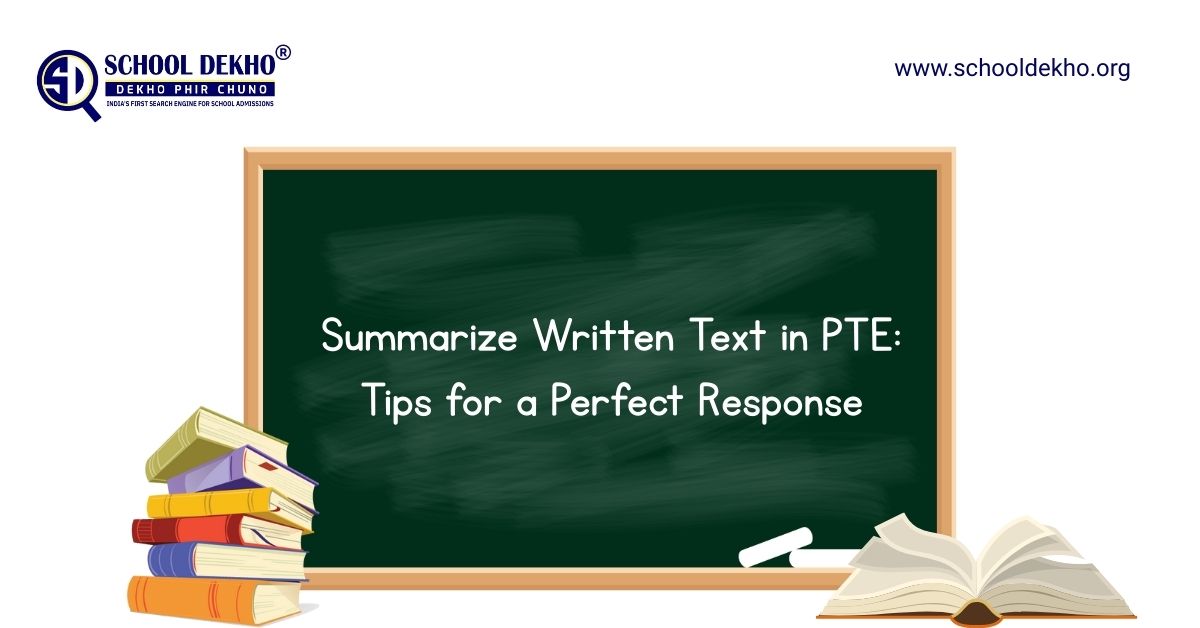Summarize Written Text in PTE: Tips for a Perfect Response

The Pearson Test of English (PTE) Academic is a computer-based test that assesses the listening, reading, speaking, and writing abilities of non-native speakers of English. One of the significant tasks in the writing section is “summarize written text PTE,” where examinees have to go through a question and write a single-sentence summary from it, which should be completed within 10 minutes.
While the task might sound simple, that’s because it tests your reading comprehension skills in the areas of grammar, vocabulary, and sentence structuring. This guide describes effective tips and strategies to help you to write a perfect response and achieve your best score in the Summarize Written Text section.
Understanding the Task
In the Summarize Written Text task:
You are given a passage of about 200-300 words.
Your task is to write the summary in a single sentence only, no longer than 75 words.
You have 10 minutes to do this task.
Scoring Criteria
Your response is scored on:
1. Content: How well you present the main idea and essential supporting points.
2. Form: One sentence, no more than 75 words, and grammatically complete.
3. Grammar: There is no misuse of tenses, punctuation, or structure.
4. Vocabulary: Correct and varied word choices.
1) Understand the Main Idea First
Read the selection carefully before you try to write anything. What you want to find is the main idea, which generally appears.
In the first or last sentence
Repeated or emphasized throughout the passage
Supported by the rest of the passage
Strategy:
First skim, then read in more depth.
Highlight keywords or topic sentences.
Ask yourself, “What is the passage mostly about?”
Try not to include too much information. Consider the central theme and the key point(s) that are most integral to that structure.
2) Plan Before You Write
Jumping straight into writing can result in a disorganized or incomplete sentence. Use the first couple of minutes to:
Note down the key points or keywords.
Decide how you will connect these points grammatically.
Helpful Tools:
Bullet-point the main idea and 1–2 supporting ideas.
Create a mental outline of your sentence.
This planning ensures you remain within the word limit and keeps your sentence focused.
3) Use Complex Sentence Structures
The task requires you to write one single sentence, but that sentence can be complex. Using linking words and conjunctions helps you express multiple ideas within a single, grammatically correct structure.
Useful Connectors:
Although
While
Because
Due to
Despite
As a result
Which
That
Example:
Poor: “The article talks about climate change. It also mentions global policies.” (Two sentences = incorrect)
Better: “The article is about climate change and focuses on global policies to mitigate its effects.” (One complete sentence)
4) Stay within the Word Limit
The word limit of the task is 5-75 words. But a well-crafted sentence is generally between 35 and 55 words. Writing too many words may result in forgetting crucial information, while writing too many words may make the sentence hard to follow or result in a penalty. You can also summarize written text easily with AlfaPTE.
Strategy:
After you have finished writing, count your words in the box below the text (the word count is shown on the screen).
Cut out unnecessary words or phrases that are too long.
5) Avoid Opinions and Interpretation
The conclusion does not need to be objective. Do not include your personal opinions, guesses, or speculation. In other words, just stick to what the passage says.
Example:
Wrong: “The writer clearly feels that the government policies are not working.”
Right: “The passage expresses concern about the effectiveness of government policies.
Keep a neutral and academic tone.
6) Master Grammar and Punctuation
As you have to answer in one sentence, wrong punctuation or incomplete writing could lose you a lot of points!!
Grammar Points to Master:
Subject-verb agreement
Tense consistency
Correct use of commas and semicolons
Relative clauses (which, that, who)
Common Mistake:
Wrong: “The article explains the effect of pollution; it also discusses recycling.”
(That’s a comma splice—two independent clauses incorrectly connected by a comma.)
Right: “The story describes what happens when there is pollution and talks about recycling.”
7) Practice with a Timer
You have only 10 minutes per item, so you need to practice under timed conditions.
Suggested Timing Strategy:
2 minutes: Read the passage and find answers to the questions.
3 minutes: Note down key points and plan your sentence.
3 minutes: Write your summary.
2 minutes: Review grammar, spelling, and punctuation.
Regular work helps you increase your reading speed, planning skills, and accuracy in writing under pressure.
8) Leveraging AlfaPTE (App-Based Prep)
AI scoring: Immediate, high-accuracy feedback (~95%) mirrors real PTE grading.
Sectional mocks & templates: Includes ready-to-use summary frameworks.
Strategy videos and tutorials: Explicit guidance on summarizing and paraphrasing
Post-performance analytics: in-depth breakdown of weak areas vs. strong areas
Offline access & multi-language support: Keeps your prep on track and available anytime, anywhere.
9) Expand Your Vocabulary
To express complex concepts clearly and concisely, you must have a strong command of vocabulary – including academic and content-specific terms.
How to Improve:
Read newspapers, journals, and essays.
Practice paraphrasing: write a new sentence to convey the same idea.
Learn synonyms for overused words (e.g., “important” → “significant,” “shows” → “demonstrates”).
Avoid overusing simple words. Use “effective,” “beneficial,” or “advantageous,” as appropriate, not “good.”
10) Review Sample Answers
By reading and analyzing sample responses, you will discover how the high-scoring answers are structured.
What to Look For:
How the main idea is introduced
Which connectors are used?
Sentence length and flow
Vocabulary precision
Compare between examples (which are high and low scoring); from there, you'll start to identify what works and what doesn't.
Conclusion
Success in the “summarize written text PTE” lies in three things: understanding, focus, and conciseness. Developing the ability to quickly understand a passage and articulate its core message in one grammatically correct sentence is a skill that can be developed with regular practice. Focus on:
1. Efficient reading and note-taking
2. Paraphrasing skills
3. Single-sentence synthesis with academic language
4. Sharp grammar and punctuation
5. Strict time discipline
6. Regular, smart practice using quality tools (such as AlfaPTE)
By implementing the strategies in this blog, avoiding some of the common mistakes, and practicing regularly under timed conditions, you will gain and substantially raise your performance in this section of the test.






